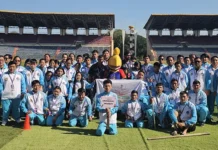[Tongam Rina]
ITANAGAR, 8 Aug: The Rajya Sabha was informed that the 11,000 MW Upper Siang multipurpose storage project in Arunachal Pradesh is currently at the preliminary stage of investigation.
Two questions related to the project, which has been riddled with protests, were raised by the All India Trinamool Congress MPs in the Rajya Sabha.
The union power minister stated that environmental clearance (EC) is required before starting construction of such a project. The EC process involves a detailed study of baseline data on flora, fauna, socioeconomic status, and other environmental parameters.
Responding to a question raised by Sushmita Dev about whether the government is aware of the ongoing protests against the project and the measures being undertaken to address concerns regarding environmental impact, biodiversity loss, and the displacement of locals, the power minister stated that “outreach and awareness activities are being conducted to alleviate the fears of the villagers.”
Acknowledging that local villagers have raised concerns over the Upper Siang multipurpose project, the minister said that “these concerns are being addressed through confidence-building measures and outreach activities.”
The minister further said that the project-affected persons are being suitably compensated by the project developer, according to the rehabilitation scheme approved by the state government.
Another question was raised by Mohammed Nadimul Haque regarding the environmental impact of the Upper Siang hydroelectric project, including the likely submergence of the ancestral lands of the Adi community, their displacement, and measures taken to address the loss of land for over one lakh Adi population and the displacement of families in the village.
The environment, forest and climate change minister stated that the ministry has not received any proposal for a new terms of reference (ToR) for conducting an environmental impact assessment (EIA). The ministry had granted a ToR for conducting an EIA for the proposed construction of the Siang Upper HEP Stage-II (3,750 MW) project in Upper Siang via a letter dated 22 October, 2014, with a validity period of three years from the date of issuance for the submission of the EIA/EMP report along with public consultation.
The ToR lapsed after the three-year period on 21 October, 2017.
To date, the ministry has not received any proposal for a new ToR for the EIA of the Upper Siang project.
Earlier, the Siang Indigenous Farmers Forum, the Dibang Resistance, and the North East Human Rights had submitted a representation to the Centre, suggesting that, “instead of mega projects, the Indian government should explore alternative energy solutions that align with the state’s unique ecological context.”
The Adi Bane Kebang, the apex body of the Adis, had previously agreed to a pre-feasibility report on the project, prompting protests from various organisations.
Addressing a public meeting in January this year, Chief Minister Pema Khandu had stated that the proposed Siang hydropower project would only proceed after consultations and obtaining the consent of the people. However, this promise seems to have been overlooked as he began his third term as chief minister.
On 8 July, during the visit of the union power minister, the government detained activist lawyer Ebo Mili and Siang Indigenous Farmers’ Forum convener Dunge Apang while the union power minister was in Itanagar.
The project proposal in the Siang valley has undergone changes.
The Niti Aayog proposed a 10,000 MW Siang project, aimed to build a single multipurpose river valley project for the Siang River, featuring a 300-metre-high dam and a power generation capacity of 10,000 MW to “moderate floods and erosion, providing relief in downstream river reaches of Arunachal and Assam.”
The government had initially planned the Lower Siang HEP (2,700 MW) and the Siang Upper HEP Stage-II (3,750 MW) projects in the Siang basin,which faced resistance but was later expanded to 11,000 MW, without conducting fresh studies.



